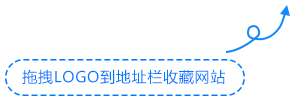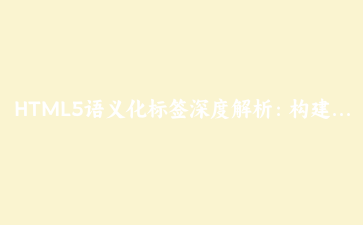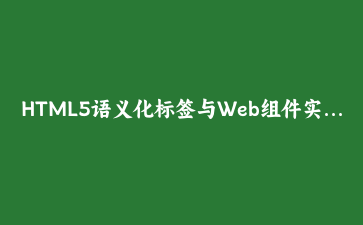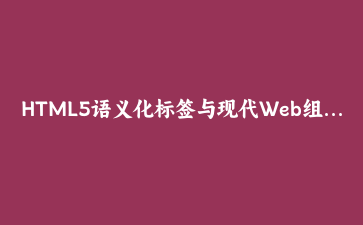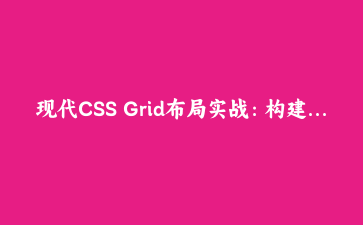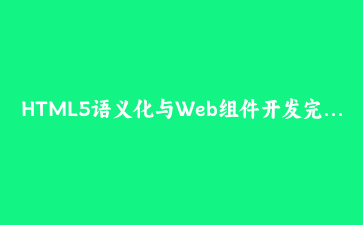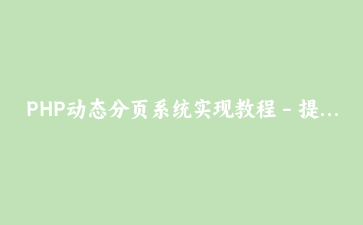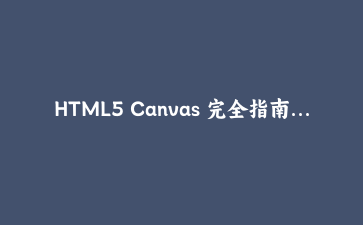发布日期:2024年1月 | 作者:Web标准倡导者
一、语义化HTML:现代Web开发的基石
什么是语义化HTML?
语义化HTML是指使用恰当的HTML标签来准确描述内容的意义和结构,而不仅仅是定义外观。HTML5引入了一系列新的语义化标签,让开发者能够创建更具表达力的网页结构。
语义化的重要性:
- 提升可访问性:屏幕阅读器能够更好地理解页面结构
- 改善SEO:搜索引擎更容易抓取和理解内容
- 增强可维护性:代码更清晰,易于团队协作
- 未来兼容性:符合Web标准,适应新技术发展
传统div布局 vs 语义化布局
对比传统div布局与语义化布局的差异:
传统div布局(不推荐):
<div id="header">
<div class="nav">...</div>
</div>
<div class="main">
<div class="sidebar">...</div>
<div class="content">...</div>
</div>
<div id="footer">...</div>语义化布局(推荐):
<header>
<nav>...</nav>
</header>
<main>
<aside>...</aside>
<article>...</article>
</main>
<footer>...</footer>二、结构语义标签深度解析
<header> 标签的正确使用
<header> 表示介绍性内容或导航链接的容器,通常包含标题、Logo、导航菜单等。
使用示例:
<header role="banner">
<h1>网站主标题</h1>
<img src="logo.png" alt="公司Logo">
<nav aria-label="主导航">
<ul>
<li><a href="/" rel="external nofollow" rel="external nofollow" >首页</a></li>
<li><a href="/about" rel="external nofollow" rel="external nofollow" >关于我们</a></li>
<li><a href="/contact" rel="external nofollow" rel="external nofollow" >联系我们</a></li>
</ul>
</nav>
</header>注意事项:
- 一个页面可以有多个 <header> 元素
- 通常作为 <body>、<article> 或 <section> 的子元素
- 建议添加适当的ARIA角色增强可访问性
<main> 与 <article> 的区分使用
理解这两个核心内容容器的不同用途:
<main> 使用示例:
<main id="main-content" role="main">
<h1>文章标题</h1>
<article>
<h2>独立文章内容</h2>
<p>这是一篇可以独立分发的内容...</p>
</article>
<section aria-labelledby="related-heading">
<h2 id="related-heading">相关内容</h2>
<!-- 相关内容 -->
</section>
</main><article> 使用场景:
<article class="blog-post">
<header>
<h1>博客文章标题</h1>
<time datetime="2024-01-15">2024年1月15日</time>
<address>作者:张三</address>
</header>
<section>
<h2>章节标题</h2>
<p>文章内容段落...</p>
<figure>
<img src="image.jpg" alt="描述图片内容">
<figcaption>图片说明文字</figcaption>
</figure>
</section>
<footer>
<p>标签:HTML, 语义化, 前端开发</p>
</footer>
</article><section> 与 <div> 的选择策略
理解何时使用 <section> 而不是通用的 <div>:
应该使用 <section> 的情况:
<article>
<section aria-labelledby="intro-heading">
<h2 id="intro-heading">介绍</h2>
<p>本节介绍文章的主要内容...</p>
</section>
<section aria-labelledby="methods-heading">
<h2 id="methods-heading">方法</h2>
<p>详细描述实现方法...</p>
</section>
<section aria-labelledby="results-heading">
<h2 id="results-heading">结果</h2>
<p>展示实验结果...</p>
</section>
</article>应该使用 <div> 的情况:
<div class="button-group" role="group" aria-label="操作按钮">
<button>保存</button>
<button>取消</button>
</div>
<div class="styling-wrapper">
<!-- 仅用于样式包装,无语义含义 -->
</div>三、内容语义标签的精准应用
<figure> 与 <figcaption> 组合使用
为图片、图表、代码等独立内容提供语义化包装:
<figure role="figure" aria-labelledby="fig1-caption">
<pre><code>
function semanticHTML() {
return '构建可访问的Web内容';
}
</code></pre>
<figcaption id="fig1-caption">
图1: JavaScript函数示例代码
</figcaption>
</figure>
<figure>
<img src="chart.png"
alt="2023年网站流量统计图表,显示1月到12月的访问量趋势">
<figcaption>
图2: 2023年月度网站访问量统计
</figcaption>
</figure><time> 标签的datetime属性
为时间信息提供机器可读的格式:
<article>
<header>
<h1>技术文章标题</h1>
<p>
发布日期:
<time datetime="2024-01-15T09:00:00+08:00">
2024年1月15日上午9点
</time>
</p>
<p>
最后更新:
<time datetime="2024-01-20T14:30:00+08:00">
3天前
</time>
</p>
</header>
</article>
<div class="event-schedule">
<h2>活动时间表</h2>
<ul>
<li>
<time datetime="2024-02-01">2月1日</time>:
主题演讲
</li>
<li>
<time datetime="2024-02-01T14:00:00">
下午2点
</time>:
技术研讨会
</li>
</ul>
</div><mark> 高亮重要内容
突出显示在当前上下文中相关或重要的文本:
<article>
<p>
在Web开发中,<mark>语义化HTML</mark>是构建
可访问网站的基础。通过使用恰当的标签,我们不仅
提升了<mark>用户体验</mark>,还改善了
<mark>搜索引擎优化</mark>效果。
</p>
<blockquote>
<p>
"<mark>可访问性</mark>不是可选的附加功能,
而是Web开发的核心要求。"
</p>
</blockquote>
</article>四、可访问性实战:构建屏幕阅读器友好的博客页面
完整博客文章结构示例
<!DOCTYPE html>
<html lang="zh-CN">
<head>
<meta charset="UTF-8">
<title>HTML5语义化标签在现代Web开发中的应用 | 技术博客</title>
</head>
<body>
<a href="#main-content" rel="external nofollow" class="skip-link">跳到主要内容</a>
<header role="banner">
<h1>前端技术博客</h1>
<nav aria-label="主导航">
<ul>
<li><a href="/" rel="external nofollow" rel="external nofollow" aria-current="page">首页</a></li>
<li><a href="/tutorials" rel="external nofollow" >教程</a></li>
<li><a href="/resources" rel="external nofollow" >资源</a></li>
</ul>
</nav>
</header>
<main id="main-content" role="main">
<article class="blog-article">
<header>
<h1>HTML5语义化标签深度解析</h1>
<div class="article-meta">
<address>作者:<a href="/author/li" rel="external nofollow" >李四</a></address>
<time datetime="2024-01-15T10:00:00+08:00">
2024年1月15日
</time>
</div>
</header>
<section aria-labelledby="introduction-heading">
<h2 id="introduction-heading">引言</h2>
<p>在现代Web开发中,语义化HTML扮演着至关重要的角色...</p>
</section>
<section aria-labelledby="benefits-heading">
<h2 id="benefits-heading">语义化的优势</h2>
<ul>
<li>提升可访问性</li>
<li>改善SEO效果</li>
<li>增强代码可维护性</li>
</ul>
</section>
<section aria-labelledby="examples-heading">
<h2 id="examples-heading">实际应用示例</h2>
<figure>
<img src="code-example.png"
alt="HTML5语义化标签使用示例代码截图">
<figcaption>图1: 语义化HTML代码示例</figcaption>
</figure>
</section>
<footer>
<section aria-labelledby="tags-heading">
<h3 id="tags-heading">文章标签</h3>
<ul class="tag-list">
<li><a href="/tag/html5" rel="external nofollow" rel="tag">HTML5</a></li>
<li><a href="/tag/semantic" rel="external nofollow" rel="tag">语义化</a></li>
<li><a href="/tag/accessibility" rel="external nofollow" rel="tag">可访问性</a></li>
</ul>
</section>
</footer>
</article>
<aside aria-labelledby="related-heading">
<h2 id="related-heading">相关文章</h2>
<ul>
<li><a href="/aria-guide" rel="external nofollow" >ARIA属性使用指南</a></li>
<li><a href="/css-grid" rel="external nofollow" >CSS Grid布局实战</a></li>
</ul>
</aside>
</main>
<footer role="contentinfo">
<p>© 2024 前端技术博客. 保留所有权利.</p>
<nav aria-label="页脚导航">
<ul>
<li><a href="/about" rel="external nofollow" rel="external nofollow" >关于我们</a></li>
<li><a href="/contact" rel="external nofollow" rel="external nofollow" >联系我们</a></li>
<li><a href="/privacy" rel="external nofollow" >隐私政策</a></li>
</ul>
</nav>
</footer>
</body>
</html>五、语义化HTML对SEO的积极影响
搜索引擎如何理解语义化标签
- 内容层次结构:搜索引擎通过语义标签理解内容的重要性
- 关键词相关性:<main>、<article> 中的内容权重更高
- 结构化数据:语义标签提供天然的微数据支持
- 用户体验信号:良好的可访问性间接提升SEO排名
SEO最佳实践
<!-- 良好的SEO结构 -->
<article itemscope itemtype="http://schema.org/Article">
<header>
<h1 itemprop="headline">文章标题</h1>
<div itemprop="author" itemscope itemtype="http://schema.org/Person">
<span itemprop="name">作者姓名</span>
</div>
<time itemprop="datePublished" datetime="2024-01-15">
2024年1月15日
</time>
</header>
<div itemprop="articleBody">
<p>文章主要内容...</p>
</div>
</article>六、语义化HTML开发最佳实践
开发原则总结
- 内容决定标签:根据内容含义选择标签,而不是外观
- 层次结构清晰:合理嵌套标题标签(h1-h6)
- ARIA属性补充:在语义不足时使用ARIA角色增强
- 渐进增强:确保在不支持新标签的浏览器中正常显示
- 测试验证:使用屏幕阅读器和验证工具测试可访问性
常见错误与修正
错误示例:
<!-- 错误:滥用语义标签 -->
<section>
<div>
<span>这是一个按钮</span>
</div>
</section>修正版本:
<!-- 正确:使用恰当的语义 -->
<button type="button">
这是一个按钮
</button>工具与资源推荐
- 验证工具:W3C HTML验证器、axe可访问性测试工具
- 浏览器扩展:Web Developer Toolbar、Accessibility Insights
- 学习资源:MDN Web文档、WebAIM指南
- 测试工具:NVDA屏幕阅读器、VoiceOver(macOS)
